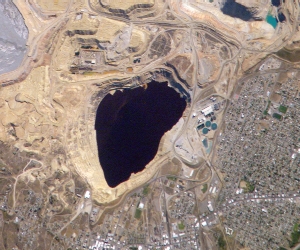 Just outside Butte, Montana lies a pit of greenish poison a mile and a half wide and over a third of a mile deep. It hasn’t always been so – it was once a thriving copper mine appropriately dubbed “The Richest Hill in the World.” Over a billion tons of copper ore, silver, gold, and other metals were extracted from the rock of southwestern Montana, making the mining town of Butte one of the richest communities in the country, as well as feeding America’s industrial might for nearly a hundred years. By the middle of the twentieth century, the Anaconda Mining Company was in charge of virtually all the mining operations. When running underground mines became too costly in the 1950’s, Anaconda switched to the drastic but effective methods of “mountaintop removal” and open pit mining. Huge amounts of copper were needed to satisfy the growing demand for radios, televisions, telephones, automobiles, computers, and all the other equipment of America’s post-war boom. As more and more rock was excavated, groundwater began to seep into the pit, and pumps had to be installed to keep it from slowly flooding.
Just outside Butte, Montana lies a pit of greenish poison a mile and a half wide and over a third of a mile deep. It hasn’t always been so – it was once a thriving copper mine appropriately dubbed “The Richest Hill in the World.” Over a billion tons of copper ore, silver, gold, and other metals were extracted from the rock of southwestern Montana, making the mining town of Butte one of the richest communities in the country, as well as feeding America’s industrial might for nearly a hundred years. By the middle of the twentieth century, the Anaconda Mining Company was in charge of virtually all the mining operations. When running underground mines became too costly in the 1950’s, Anaconda switched to the drastic but effective methods of “mountaintop removal” and open pit mining. Huge amounts of copper were needed to satisfy the growing demand for radios, televisions, telephones, automobiles, computers, and all the other equipment of America’s post-war boom. As more and more rock was excavated, groundwater began to seep into the pit, and pumps had to be installed to keep it from slowly flooding.
The Pit of Life and Death
Subscribe to:
Post Comments (Atom)

No comments:
Post a Comment